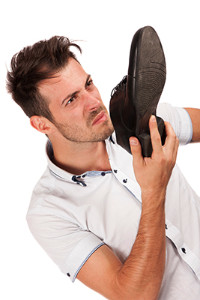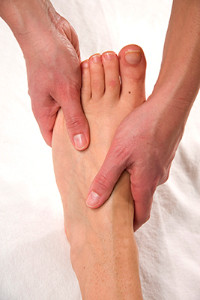
Lansdowne, PA
(610) 626-3338

Lansdowne, PA
(610) 626-3338
 If you have ever experienced an ingrown toenail, you know how painful and how much of a hindrance it can be. It occurs when part of the toenail grows into the tissue of the toe. This can turn into a serious condition, as swelling and infection may result. Medically known as onychocryptosis, this disorder is typically caused by over clipping of toenails or wearing shoes that do not fit properly. With nearly 3 million cases of patients with ingrown toenails, it is important to contact your podiatrist to learn about proper treatment.
If you have ever experienced an ingrown toenail, you know how painful and how much of a hindrance it can be. It occurs when part of the toenail grows into the tissue of the toe. This can turn into a serious condition, as swelling and infection may result. Medically known as onychocryptosis, this disorder is typically caused by over clipping of toenails or wearing shoes that do not fit properly. With nearly 3 million cases of patients with ingrown toenails, it is important to contact your podiatrist to learn about proper treatment.
Ingrown toenails can become painful if they are not treated properly. For more information about ingrown toenails, contact Dr. George Yarnell of Pennsylvania. Our doctor can provide the care you need to keep you pain-free and on your feet.
Ingrown Toenails
Ingrown toenails occur when a toenail grows sideways into the bed of the nail, causing pain, swelling, and possibly infection.
Causes
Prevention
Because ingrown toenails are not something found outside of shoe-wearing cultures, going barefoot as often as possible will decrease the likeliness of developing ingrown toenails. Wearing proper fitting shoes and using proper cutting techniques will also help decrease your risk of developing ingrown toenails.
Treatment
Ingrown toenails are a very treatable foot condition. In minor cases, soaking the affected area in salt or antibacterial soaps will not only help with the ingrown nail itself, but also help prevent any infections from occurring. In more severe cases, surgery is an option. In either case, speaking to your podiatrist about this condition will help you get a better understanding of specific treatment options that are right for you.
If you have any questions please feel free to contact our office located in Lansdowne, PA . We offer the newest diagnostic and treatment technologies for all your foot and ankle needs.
 If you begin to notice redness or dry, scaly skin around the toes, you may be suffering from Athlete’s foot. This possibility is heightened when accompanied by foul odor, which is a sign of both bacteria and fungus abrading the skin of your feet. Avoid touching the feet and then touching the rest of your body, as Athlete’s foot is communicable through contact. Moist environments should also be avoided, and be sure to wear shoes when at the gym locker room. Many over-the-counter medications are available to treat Athlete’s foot. To determine what is suitable for your case, however, it is best to consult with your podiatrist.
If you begin to notice redness or dry, scaly skin around the toes, you may be suffering from Athlete’s foot. This possibility is heightened when accompanied by foul odor, which is a sign of both bacteria and fungus abrading the skin of your feet. Avoid touching the feet and then touching the rest of your body, as Athlete’s foot is communicable through contact. Moist environments should also be avoided, and be sure to wear shoes when at the gym locker room. Many over-the-counter medications are available to treat Athlete’s foot. To determine what is suitable for your case, however, it is best to consult with your podiatrist.
Athlete’s foot is an inconvenient condition that can be easily reduced with the proper treatment. If you have any concerns about your feet and ankles, contact Dr. George Yarnell from Pennsylvania. Our doctor will treat your foot and ankle needs.
Athlete’s Foot: The Sole Story
Athlete's foot, also known as tinea pedis, can be an extremely contagious foot infection. It is commonly contracted in public changing areas and bathrooms, dormitory style living quarters, around locker rooms and public swimming pools, or anywhere your feet often come into contact with other people.
Solutions to Combat Athlete’s Foot
Athlete’s foot can cause many irritating symptoms such as dry and flaking skin, itching, and redness. Some more severe symptoms can include bleeding and cracked skin, intense itching and burning, and even pain when walking. In the worst cases, Athlete’s foot can cause blistering as well. Speak to your podiatrist for a better understanding of the different causes of Athlete’s foot, as well as help in determining which treatment options are best for you.
If you have any questions please feel free to contact our office located in Lansdowne, PA . We offer the newest diagnostic and treatment technologies for all your foot and ankle needs.
 According to a new study published in the International Journal of Dermatology on January 21, intralesional immunotherapy may be more effective than traditional cryotherapy for the treatment of wart lesions. Intralesional immunotherapy involves injecting an antigen into the wart itself, thereby inducing an immune response in the form of antibodies. Cryotherapy is essentially freezing the wart off with liquid nitrogen. For this study, the researchers used candida as the antigen and administered treatment every three weeks until “complete improvement,” with a maximum of three sessions. The cryotherapy was performed until the wart was eliminated, with a maximum of 10 sessions. Of the 60 patients, 30 in each group, 76.7% were cured by immunotherapy and 56.7% by cryotherapy.
According to a new study published in the International Journal of Dermatology on January 21, intralesional immunotherapy may be more effective than traditional cryotherapy for the treatment of wart lesions. Intralesional immunotherapy involves injecting an antigen into the wart itself, thereby inducing an immune response in the form of antibodies. Cryotherapy is essentially freezing the wart off with liquid nitrogen. For this study, the researchers used candida as the antigen and administered treatment every three weeks until “complete improvement,” with a maximum of three sessions. The cryotherapy was performed until the wart was eliminated, with a maximum of 10 sessions. Of the 60 patients, 30 in each group, 76.7% were cured by immunotherapy and 56.7% by cryotherapy.
Plantar warts can be very uncomfortable. If you need your feet checked, contact Dr. George Yarnell from Pennsylvania. Our doctor will assist you with all of your foot and ankle needs.
About Plantar Warts
Plantar warts are the result of HPV, or human papillomavirus, getting into open wounds on the feet. They are mostly found on the heels or balls of the feet.
While plantar warts are generally harmless, those experiencing excessive pain or those suffering from diabetes or a compromised immune system require immediate medical care. Plantar warts are easily diagnosed, usually through scraping off a bit of rough skin or by getting a biopsy.
Symptoms
Treatment
To help prevent developing plantar warts, avoid walking barefoot over abrasive surfaces that can cause cuts or wounds for HPV to get into. Avoiding direct contact with other warts, as well as not picking or rubbing existing warts, can help prevent the further spread of plantar warts. However, if you think you have developed plantar warts, speak to your podiatrist. He or she can diagnose the warts on your feet and recommend the appropriate treatment options.
If you have any questions please feel free to contact our office located in Lansdowne, PA . We offer the newest diagnostic and treatment technologies for all your foot and ankle needs.
Read more about All About Plantar Warts